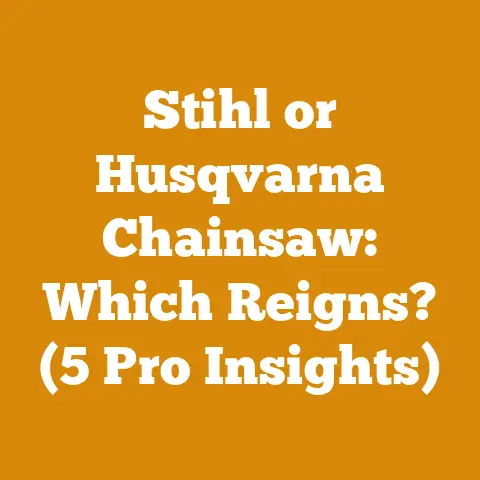Hemlock Adelgid Treatment Guide (Pro Woodworker Pest Control Tips)
The crisp morning air bites at my cheeks as I step out onto my property, the scent of pine and damp earth filling my lungs. It’s a good day to be working with wood. But lately, a shadow has fallen over these woods, a silent killer threatening the majestic hemlocks that have stood sentinel for generations: the Hemlock Woolly Adelgid (HWA). As a pro woodworker and someone deeply connected to the health of my land, I’ve had to become an amateur entomologist, learning everything I can about identifying, treating, and, when necessary, managing the impact of this invasive pest.
Hemlock Adelgid Treatment Guide (Pro Woodworker Pest Control Tips)
The Hemlock Woolly Adelgid (HWA) is a tiny, sap-sucking insect that attacks hemlock trees. Native to Asia, it was introduced to the eastern United States in the 1950s and has since spread rapidly, causing widespread hemlock decline and mortality. The telltale sign of HWA infestation is the presence of small, white, cottony masses (ovisacs) on the underside of hemlock needles, particularly at the base of the needles near the twig.
Identifying Hemlock Woolly Adelgid Infestation: The First Line of Defense
Before you even think about treatment, you need to confirm you’re dealing with HWA. Look for these key signs:
- White, Cottony Masses: These are the most obvious indicator. Inspect the underside of the outermost twigs and needles, especially in late winter and early spring.
- Needle Drop: Infested trees will often experience premature needle drop, leading to thinning crowns.
- Branch Dieback: As the infestation progresses, branches will start to die back from the tips.
- Overall Tree Decline: In severe cases, the entire tree may appear stressed, with reduced growth and a general lack of vigor.
My experience: I initially mistook the early signs of HWA for something else – perhaps a natural shedding of needles. It wasn’t until I got up close and personal, inspecting the twigs with a magnifying glass, that I saw those telltale white masses. That’s when I knew I had a problem.
Understanding the Costs: A Breakdown of Hemlock Adelgid Treatment Options
Treating HWA can be a significant investment, and the costs can vary widely depending on several factors:
- Tree Size and Number: Larger trees require more treatment, and the more trees you have, the higher the overall cost.
- Infestation Severity: Heavily infested trees may require more intensive treatment.
- Treatment Method: Different treatment methods have different costs associated with them.
- Labor Costs: If you’re hiring professionals, labor costs will be a major factor.
- Location and Accessibility: Trees in remote or difficult-to-access locations may incur higher labor costs.
- Product Costs: The cost of insecticides or other treatment products can vary significantly.
Let’s break down the most common treatment options and their associated costs:
1. Horticultural Oil Application: A Gentle Approach
Horticultural oil works by smothering the adelgids, effectively suffocating them. It’s a relatively environmentally friendly option, but it’s most effective on young infestations and requires thorough coverage.
- Cost:
- DIY: $20-$50 per gallon of concentrated horticultural oil. One gallon of concentrate can make several gallons of spray.
- Professional Application: $50-$200 per tree, depending on size and location.
- Labor: DIY application is labor-intensive, requiring careful spraying of all infested areas. Professional application includes labor costs.
- Pros: Relatively environmentally friendly, effective on young infestations.
- Cons: Requires thorough coverage, may need to be repeated, not effective on heavy infestations.
My experience: I used horticultural oil on a few smaller hemlocks that showed early signs of infestation. It was a good option for those trees, but it wouldn’t have been practical for my larger, more heavily infested trees. I also found that timing is crucial; you need to apply the oil when the adelgids are active but before they’re protected by their waxy coating.
2. Insecticidal Soap Application: Another Low-Impact Option
Similar to horticultural oil, insecticidal soap works by disrupting the adelgids’ cell membranes. It’s another relatively environmentally friendly option, but it also requires thorough coverage and may need to be repeated.
- Cost:
- DIY: $15-$40 per gallon of concentrated insecticidal soap.
- Professional Application: $40-$150 per tree, depending on size and location.
- Labor: Similar to horticultural oil, DIY application is labor-intensive.
- Pros: Relatively environmentally friendly, effective on young infestations.
- Cons: Requires thorough coverage, may need to be repeated, not effective on heavy infestations.
Industry Benchmark: According to a study by the University of Connecticut, insecticidal soap and horticultural oil are most effective when applied in early spring or late fall when the adelgids are actively feeding but before they produce their protective woolly covering.
3. Systemic Insecticides: A More Powerful Approach
Systemic insecticides are absorbed by the tree and translocated throughout its tissues, killing the adelgids as they feed. This is a more effective option for heavy infestations, but it also has potential environmental impacts.
- Imidacloprid: A common systemic insecticide that can be applied as a soil drench or trunk injection.
- Cost:
- DIY (Soil Drench): $30-$70 per quart of concentrated imidacloprid.
- Professional Application (Soil Drench): $80-$300 per tree, depending on size and location.
- Professional Application (Trunk Injection): $150-$500 per tree, depending on size and location.
- Labor: Soil drench application is relatively easy to do yourself, but trunk injection requires specialized equipment and training.
- Pros: Effective on heavy infestations, long-lasting protection.
- Cons: Potential environmental impacts, can be harmful to beneficial insects, trunk injection can wound the tree.
- Cost:
- Dinotefuran: Another systemic insecticide that is often used as a trunk spray.
- Cost:
- Professional Application (Trunk Spray): $100-$400 per tree, depending on size and location.
- Labor: Requires specialized equipment and training.
- Pros: Effective on heavy infestations, faster uptake than imidacloprid.
- Cons: Potential environmental impacts, can be harmful to beneficial insects.
- Cost:
My experience: I ultimately opted for a systemic insecticide (imidacloprid) for my larger, heavily infested trees. While I was concerned about the potential environmental impacts, I felt it was the only way to save these trees. I hired a professional arborist to do the application, as I didn’t have the equipment or expertise to do it myself.
Industry Data: A study published in the Journal of Economic Entomology found that systemic insecticides like imidacloprid and dinotefuran can provide effective control of HWA for up to two years.
4. Biological Control: A Long-Term Solution
Biological control involves introducing natural enemies of the adelgids to control their populations. This is a long-term solution that can be very effective, but it takes time to see results.
- Laricobius nigrinus: A beetle that feeds on HWA eggs.
- Cost: $5-$15 per beetle.
- Labor: Requires releasing the beetles near infested trees.
- Pros: Environmentally friendly, long-term solution.
- Cons: Takes time to see results, may not be effective in all locations.
- Sasajiscymnus tsugae: Another beetle that feeds on HWA.
- Cost: $5-$15 per beetle.
- Labor: Requires releasing the beetles near infested trees.
- Pros: Environmentally friendly, long-term solution.
- Cons: Takes time to see results, may not be effective in all locations.
My experience: I’m currently exploring biological control options for my property. I’ve contacted a local entomologist who specializes in HWA control, and we’re discussing the possibility of releasing Laricobius nigrinus beetles. It’s a long-term investment, but I believe it’s the most sustainable way to manage HWA in the long run.
Regional Data: The effectiveness of biological control agents can vary depending on the region. For example, Laricobius nigrinus has been shown to be more effective in cooler climates, while Sasajiscymnus tsugae may be more effective in warmer climates.
Cost Comparison Table: A Quick Overview
| Treatment Method | DIY Cost (per tree) | Professional Cost (per tree) | Pros | Cons |
|---|---|---|---|---|
| Horticultural Oil | $5-$20 | $50-$200 | Environmentally friendly, effective on young infestations | Requires thorough coverage, may need to be repeated, not for heavy infestations |
| Insecticidal Soap | $4-$15 | $40-$150 | Environmentally friendly, effective on young infestations | Requires thorough coverage, may need to be repeated, not for heavy infestations |
| Imidacloprid (Soil Drench) | $10-$35 | $80-$300 | Effective on heavy infestations, long-lasting protection | Potential environmental impacts, can harm beneficial insects |
| Imidacloprid (Trunk Injection) | N/A | $150-$500 | Effective on heavy infestations, long-lasting protection | Potential environmental impacts, can harm beneficial insects, trunk wounding |
| Dinotefuran (Trunk Spray) | N/A | $100-$400 | Effective on heavy infestations, faster uptake than imidacloprid | Potential environmental impacts, can harm beneficial insects |
| Biological Control | $5-$15 (per beetle) | N/A | Environmentally friendly, long-term solution | Takes time to see results, may not be effective in all locations |
Note: These costs are estimates and can vary depending on location, tree size, and other factors.
Labor Costs: DIY vs. Professional
One of the biggest factors affecting the cost of HWA treatment is labor. If you’re willing to do the work yourself, you can save a significant amount of money. However, DIY treatment can be time-consuming and physically demanding, especially for larger trees or heavily infested areas.
Here’s a breakdown of the labor involved in each treatment method:
- Horticultural Oil and Insecticidal Soap: Requires mixing the solution, transporting it to the trees, and thoroughly spraying all infested areas. This can be particularly challenging for tall trees, as you’ll need to use a ladder or sprayer extension.
- Imidacloprid (Soil Drench): Involves measuring the correct amount of insecticide, mixing it with water, and pouring it around the base of the tree. This is a relatively easy task, but it can be time-consuming if you have many trees to treat.
- Imidacloprid (Trunk Injection) and Dinotefuran (Trunk Spray): Requires specialized equipment and training. It’s generally not recommended to attempt these methods yourself.
- Biological Control: Involves releasing the beetles near infested trees. This is a relatively easy task, but it requires careful planning and monitoring.
My Experience: I initially attempted to treat some of my smaller hemlocks with horticultural oil myself. While it was manageable for a few trees, I quickly realized that it would be impossible to treat all of my trees without professional help. The sheer size of some of the trees, combined with the uneven terrain of my property, made it too difficult and time-consuming.
Industry Average: According to the U.S. Bureau of Labor Statistics, the average hourly wage for tree trimmers and pruners is around $25 per hour. Arborists with specialized knowledge of HWA treatment may charge even more.
Wood Value and Timber Loss: The Economic Impact of HWA
Beyond the direct costs of treatment, it’s important to consider the economic impact of HWA on your timber value. Hemlock is a valuable timber species, and HWA can significantly reduce its value by causing tree death and decay.
- Reduced Timber Volume: As trees die, they become unusable for timber production.
- Lower Timber Quality: HWA-infested trees may develop cracks and other defects that reduce their quality.
- Increased Harvesting Costs: Harvesting dead or dying trees can be more difficult and expensive.
Regional Data: In the Appalachian region, the estimated economic impact of HWA on the timber industry is in the millions of dollars annually.
My Experience: I’ve seen firsthand the devastating impact of HWA on timber value. A neighbor of mine had a stand of hemlocks that were heavily infested with HWA. By the time he decided to harvest them, many of the trees were already dead or dying, and the timber quality was significantly reduced. He ended up getting a fraction of what he would have gotten if he had harvested the trees before the infestation.
Long-Term Management Strategies: A Sustainable Approach
Treating HWA is not a one-time fix. It’s an ongoing process that requires a long-term management strategy. Here are some key components of a sustainable HWA management plan:
- Regular Monitoring: Regularly inspect your hemlock trees for signs of HWA infestation. Early detection is key to successful treatment.
- Integrated Pest Management (IPM): Use a combination of treatment methods, including horticultural oil, systemic insecticides, and biological control.
- Promote Tree Health: Healthy trees are more resistant to HWA infestation. Make sure your trees are properly watered, fertilized, and protected from other stressors.
- Reforestation: Consider planting HWA-resistant hemlock varieties or other native tree species to replace trees that have been killed by HWA.
- Collaboration: Work with your neighbors, local forestry agencies, and other stakeholders to develop a coordinated HWA management plan for your region.
Industry Best Practices: The USDA Forest Service recommends a multi-pronged approach to HWA management that includes monitoring, treatment, and prevention.
My Experience: I’ve learned that the key to successful HWA management is to be proactive and persistent. It’s not enough to just treat the trees once and forget about it. You need to regularly monitor your trees, adjust your treatment strategy as needed, and work to promote the overall health of your forest.
Budgeting for Hemlock Woolly Adelgid Treatment: A Practical Guide
Now that you understand the different treatment options and their associated costs, let’s talk about budgeting for HWA treatment. Here’s a step-by-step guide to creating a realistic budget:
- Assess the Scope of the Problem: Determine the number of hemlock trees you have, the severity of the infestation, and the size of the trees.
- Choose Your Treatment Method(s): Based on the scope of the problem, choose the treatment method(s) that are most appropriate for your situation.
- Estimate Material Costs: Calculate the cost of insecticides, horticultural oil, biological control agents, and any other materials you’ll need.
- Estimate Labor Costs: If you’re hiring professionals, get quotes from several different arborists and compare their prices. If you’re doing the work yourself, estimate the number of hours it will take and multiply that by your hourly wage (or the value of your time).
- Factor in Travel Costs: If you’re hiring professionals, factor in any travel costs they may charge.
- Add a Contingency Fund: It’s always a good idea to add a contingency fund to your budget to cover unexpected costs. I recommend adding at least 10% to your total estimated cost.
- Review and Adjust: Once you’ve created your initial budget, review it carefully and make any necessary adjustments.
Example Budget:
Let’s say you have 10 hemlock trees that are moderately infested with HWA. You decide to treat them with a combination of horticultural oil and imidacloprid soil drench. You plan to do the work yourself.
- Horticultural Oil: $30 (1 gallon of concentrate)
- Imidacloprid: $150 (2 quarts of concentrate)
- Labor: 20 hours at $20/hour = $400
- Travel: $20 (gasoline)
- Contingency Fund: 10% of total = $60
- Total Estimated Cost: $660
Cost Optimization Tips:
- DIY Treatment: Doing the work yourself can save you a significant amount of money.
- Shop Around: Get quotes from several different arborists and compare their prices.
- Buy in Bulk: Buying insecticides and other materials in bulk can often save you money.
- Apply for Grants: Some government agencies and non-profit organizations offer grants to help landowners manage HWA.
- Prioritize Treatment: Focus on treating the most valuable trees first.
- Preventative Measures: Implementing preventative measures, such as promoting tree health, can help reduce the need for expensive treatments in the future.
The Role of Proper Chainsaw Use in Maintaining Hemlock Health
While not directly a treatment for HWA, proper chainsaw use and tree care practices are crucial for maintaining the overall health of hemlocks and mitigating the impact of HWA.
- Pruning Dead or Dying Branches: Removing dead or dying branches can help improve the overall health of the tree and reduce the spread of HWA. Use proper pruning techniques to avoid damaging the tree.
- Thinning Overcrowded Stands: Thinning overcrowded stands of hemlocks can improve air circulation and reduce the humidity that HWA thrives in.
- Removing Infested Trees: In severe cases, it may be necessary to remove heavily infested trees to prevent the spread of HWA to other trees. Use proper felling techniques to avoid damaging surrounding trees.
- Chainsaw Maintenance: A sharp and well-maintained chainsaw is essential for safe and efficient tree care. Regularly sharpen your chain, clean your saw, and lubricate the moving parts.
My Experience: I’ve found that regular pruning and thinning can significantly improve the health of my hemlocks. By removing dead or dying branches and thinning overcrowded stands, I’ve been able to improve air circulation and reduce the humidity that HWA thrives in. I always make sure to use proper chainsaw techniques and wear appropriate safety gear when working with trees.
Chainsaw Cost Considerations:
- Chainsaw Purchase: The cost of a chainsaw can range from $100 for a small electric saw to $1,000 or more for a professional-grade gas-powered saw.
- Chainsaw Maintenance: The cost of chainsaw maintenance can include sharpening chains, replacing parts, and servicing the engine.
- Safety Gear: The cost of safety gear can include a helmet, eye protection, ear protection, gloves, and chaps.
The Future of Hemlock Forests: A Call to Action
The future of our hemlock forests is uncertain. HWA is a serious threat, but it’s not insurmountable. By taking action now, we can protect these valuable trees and ensure that they continue to thrive for generations to come.
- Educate Yourself: Learn as much as you can about HWA and its impact on hemlock forests.
- Take Action: Implement a HWA management plan for your property.
- Spread the Word: Talk to your neighbors, friends, and family about HWA and encourage them to take action.
- Support Research: Support research efforts to develop new and more effective methods for controlling HWA.
- Get Involved: Join a local forestry organization or volunteer with a HWA management project.
My Final Thoughts:
Dealing with HWA is a challenge, but it’s a challenge worth fighting. Hemlocks are an integral part of our ecosystem, providing habitat for wildlife, protecting water quality, and adding beauty to our landscapes. By working together, we can protect these valuable trees and ensure that they continue to thrive for generations to come. Remember to always factor in the costs – not just the financial ones, but also the cost to our environment and our communities – when making decisions about HWA treatment. And never underestimate the power of a well-maintained chainsaw in promoting the overall health of your forest. Now, let’s get to work!






